What is ATX?
History of ATX
In 1995, Intel developed and released the ATX (Advanced Technology eXtended) motherboard and power supply specification. Unlike previous specifications, the ATX motherboard rotated the CPU's position and DRAM, allowing larger expansion cards to be plugged into all the motherboard sockets. Thanks to Intel's market dominance, the standard quickly caught on, and today it is the most popular Motherboard and power supply specification.
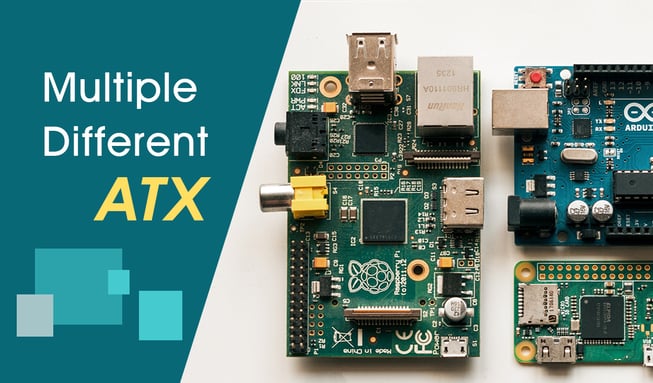
Why are there multiple different ATX form factors?
The ATX specification has several different form factors to accommodate applications and use cases, with varying board dimensions and expansion port standards. Despite the changes in size throughout the ATX form factors, the same mounting and I/O back panel positioning is used. This standardization allows smaller ATX form factor motherboards, such as microATX, to fit into any computer case designed for microATX or larger-sized ATX motherboard form factor. Generally speaking, as long as the case you purchase is intended for the ATX form factor size motherboard that you have or is designed for any larger size ATX form factor motherboard than the one you have, it should be compatible with your board. Issues can arise when manufacturers do not strictly follow the ATX motherboard configuration, as is sometimes the case with E-ATX motherboards.
Types of ATX Motherboards
1. E-ATX Board
- 12 × 13 in (305 × 330 mm)
- More DRAM and expansion slots
- 12 × 10.1 in (305 × 257 mm)
- 12 × 10.4 in (305 × 264 mm)
- 12 × 10.5 in (305 × 267 mm)
- 12 × 10.7 in (305 × 272 mm)
2. ATX Standard Board
- 12 × 9.6 in (305 × 244 mm)
- Original ATX form factor
3. microATX Board
- 9.6 × 9.6 in (244 × 244 mm)
- Also known as μATX, uATX, and mATX
4. Mini-ATX Board
- 5.9 × 5.9 in (150 × 150 mm)
- Also known as Mini ATX
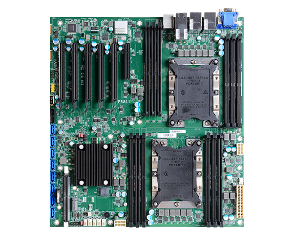
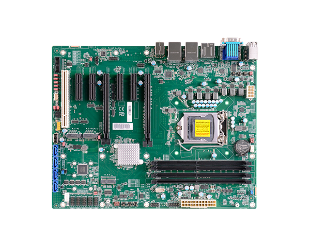

E-ATX Board
Although many large specialty motherboard form factors exist on the market, the largest standardized ATX Motherboard is E-ATX. Officially, E-ATX is 12 × 13 in (305 × 330 mm), but many manufacturers also refer to motherboards with the following sizes as E-ATX:
What is the smallest ATX motherboard?
microATX Board
Excluding Mini-ATX, which did not receive widespread adoption, microATX is the smallest ATX motherboard form factor on the market, with dimensions of 6 × 9.6 in (244 × 244 mm).
Mini-ATX Board
Not to be confused with Mini-ITX, Mini-ATX is a generic name to describe small ATX boards with a dimension of 5.9 × 5.9 in (150 × 150 mm). To standardize the form factor, a few companies have embraced the Mini-ATX size specification; however, it is too small to apply to modern power delivery requirements and has not gained widespread adoption.
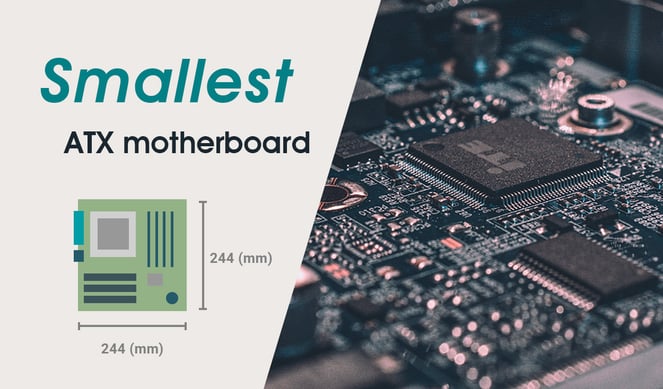
What are the benefits of ATX motherboards?
Advanced Image Processing
Due to the advanced computing, networking, and storage requirements in high-performance computing-required solutions, the ATX standard motherboards have occupied the top place in the automation field. Besides the robust processors, the abundant expansions for memory and GPU also help boost the quality and speed in graphics analysis, precisely what applications with heavy workloads, like defect inspection, medical imaging, and intelligent diagnosis, require.
High Computing Capability
ATX motherboards adopt high computing capability, rich I/O connectivity, high integration, and excellent expandability for graphics cards, motion control cards, and memory. The robust processors and add-on powerful GPU make it an ideal solution for industrial automation and medical imaging, like machine vision, MRI, and CT imaging, that require reliability & add-on-card expansibility.
Highly Scalable and Flexible
Thanks to its widespread adoption throughout industrial and consumer applications, it's evident that ATX is a standard that is here to stay. ATX's flexibility to work in many different-sized applications and the standardization that consumers and engineers have come to rely on have made it a core consideration when designing computer systems.
What are the applications that ATX motherboards use?
Industrial Automation
ATX motherboards are equipped with robust scalability in data and graphics computing processing performance to ensure the productivity and quality of factories. These solutions lend themselves to various industrial automation solutions, such as graphic processing, data center, and server communications. AI/machine learning and AOI inspection requirements are also effectively managed.
Paired with the high-performance specification features supporting numerous expansion slots, boasting flexible PCIe reconfigurability, and diverse I/O connectivity options, which are outstanding from other form factors of industrial motherboards, ATX motherboards are commonly designed to excel AI performance at the edge. Empowered by multithreaded processing, ATX motherboards ensure consistent performance under heavy workloads, and the AI-boosting expansions further upgrade the processing speed and the quality of image analysis.
Gaming
The most important consideration when selecting a motherboard for high-end gaming is expansion. At a minimum, the Motherboard will need one PCIe slot for a discrete graphics card, so all boards smaller than Mini-ITX motherboard are out of the race. If only one graphics card is required, and total system size and weight are important to the user, Mini-ITX Motherboard motherboard is perfect. Although Mini-ITX is not ATX, boards with the Mini-ITX specification will fit into ATX cases. If the user wishes to install two graphics cards and requires a higher total DRAM capacity, a microATX board is an excellent option. Finally, if the user wishes to install more than two graphics cards or two graphics cards in addition to other PCIe expansion cards, such as capture cards or sound cards, then a Standard-ATX motherboard is the best choice.
Medical
Medical equipment requires outstanding graphics capabilities. Utilizing high-resolution images and video clips from a wide range of modalities is a crucial factor that impacts diagnostic accuracy. With leading-edge features, DFI's ATX motherboards significantly benefit healthcare clients, maximizing flexibility and user experience. Since image quality and analysis are critical for CT and MRI images with high clarity to help doctors diagnose accurately, DFI's ATX motherboards are ideally suited for applications that require high precision with no errors.
How to select a Motherboard to fit your needs?
The size or form factor of the Motherboard
When choosing a motherboard, it's great to start with the size or the form factor of the Motherboard; since it determines how the equipment works in different applications and the equipment space requirements. The size or form factor will tell you what kind of case the Motherboard will fit in. Generally, production line equipment in the manufacturing industry and high-performance processing requires a larger-sized board. Additional requirements such as AI visual inspection on production lines or AI data analysis in enterprise server rooms commonly choose the ATX motherboard form factor, which provides more advanced and complete solutions.
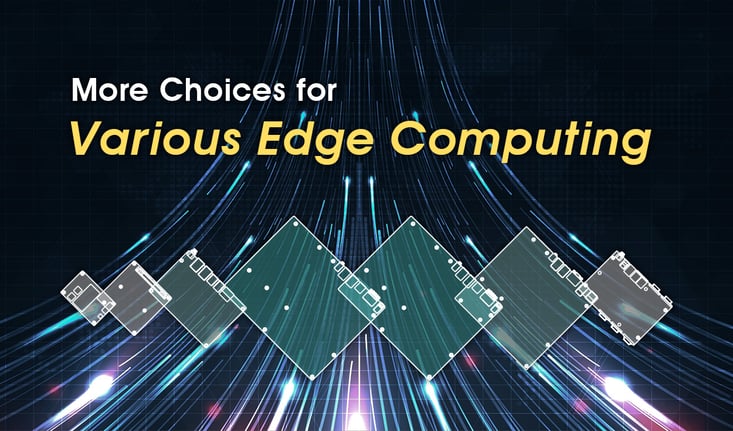
Application fields
Industrial motherboards are diverse, each with its unique characteristics. Different motherboards have their features to be implemented according to various application fields. It depends on the equipment that will be used in each environment. For example, manufacturing sites or transportation environments often encounter significant vibrations, damaging the equipment. Thus, anti-vibration is crucial for the device in those environments. In addition to the unique function, in outdoor conditions, the device always will be designed with rugged designs such as wide-temperature, wide-voltage tolerances, waterproofing, and dust proofing. All these designs are implemented to strengthen the stability of the equipment.
Which Specification is Needed in Your Equipment?
Knowing the features and specifications of different motherboards can help you determine which Motherboard is suitable for your device. Embedded motherboards come in various sizes, with functionality and I/O that determine what other components are supported by your computer. Generally speaking, the most significant differences between IPC motherboards are the CPU, motherboard chipsets, and the respective I/O interfaces. You can choose the most important function that your equipment requires, whether Intel or AMD processors, specific sockets, PCIE slots, and I/O specs to function. You can choose from either Intel motherboard or AMD motherboard based on your applications or use cases environment.
Founded in 1981, DFI is a global leading provider of high-performance computing technology across multiple embedded industries. With its innovative design and premium quality management system, DFI’s industrial-grade solutions enable customers to optimize their equipment and ensure high reliability, long-term life cycle, and 24/7 durability in a breadth of markets including Industry Automation, Medical, Gaming, Transportation, Energy, mission-critical, and intelligent retail.


